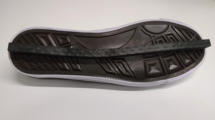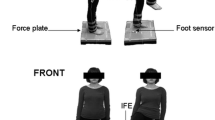Abstract
The ankle joint muscles can contribute to balance during walking by modulating the center of pressure and ground reaction forces through an ankle moment. This is especially effective in the sagittal plane through ankle plantar- or dorsiflexion. If the ankle joints would be physically blocked to make an ankle strategy ineffective, there would be no functional contribution of these muscles to balance during walking, nor would these muscles generate afferent output regarding ankle joint rotation. Consequently, ankle muscle activation for the purpose of balance control would be expected to disappear.
To investigate human balance control, we have performed an experiment in which subjects received anteroposterior pelvis perturbations during walking while the ankle joints could not contribute to the balance recovery. The latter was realized by physically blocking the ankle joints through a pair of modified ankle-foot orthoses. Here, we present the lower-limb muscle activity responses in reaction to these perturbations. Of particular interest are the tibialis anterior and gastrocnemius medialis muscles, as these could not contribute to the balance recovery through the ankle joint, nor encode muscle length changes caused by ankle joint rotation. Yet, these muscles showed long-latency responses approximately 100 ms after perturbation onset, even though the ankle joints were blocked. The response amplitudes were dependent on the perturbation magnitude and direction, as well as the state of the leg. The results suggest a centralized regulation of balance control involving supra-spinal neural structures, without the need for changes in ankle muscle proprioceptive information.
The study in this work was supported by the BALANCE (Balance Augmentation in Locomotion, through Anticipative, Natural and Cooperative control of Exoskeletons) project, partially funded under grant 601003 of the Seventh Framework Program (FP7) of the European Commission (Information and Communication Technologies, ICT-2011.2.1).
Access this chapter
Tax calculation will be finalised at checkout
Purchases are for personal use only
Similar content being viewed by others
References
Hof, A.L.: The ground reaction vector in walking passes always (almost) through the same point. J. Biomech. 46, 631–632 (2013). 2028
Nashner, L.M., Cordo, P.J.: Relation of automatic postural responses and reaction-time voluntary movements of human leg muscles. Exp. Brain Res. 43, 395–405 (1981). 2028
Vlutters, M., van Asseldonk, E.H.F., van der Kooij, H.: Center of mass velocity-based predictions in balance recovery following pelvis perturbations during human walking. J. Exp. Biol. 219, 1514–1523 (2016)
Vlutters, M., van Asseldonk, E.H.F., van der Kooij, H.: Reduced center of pressure modulation elicits foot placement adjustments, but no additional trunk motion during anteroposterior-perturbed walking. J. Biomech. (2018, in press)
Author information
Authors and Affiliations
Editor information
Editors and Affiliations
Rights and permissions
Copyright information
© 2019 Springer Nature Switzerland AG
About this paper
Cite this paper
Vlutters, M., van Asseldonk, E., van der Kooij, H. (2019). Are Ankle Muscle Responses in Balance Recovery Hard-Wired?. In: Masia, L., Micera, S., Akay, M., Pons, J. (eds) Converging Clinical and Engineering Research on Neurorehabilitation III. ICNR 2018. Biosystems & Biorobotics, vol 21. Springer, Cham. https://doi.org/10.1007/978-3-030-01845-0_58
Download citation
DOI: https://doi.org/10.1007/978-3-030-01845-0_58
Published:
Publisher Name: Springer, Cham
Print ISBN: 978-3-030-01844-3
Online ISBN: 978-3-030-01845-0
eBook Packages: EngineeringEngineering (R0)




